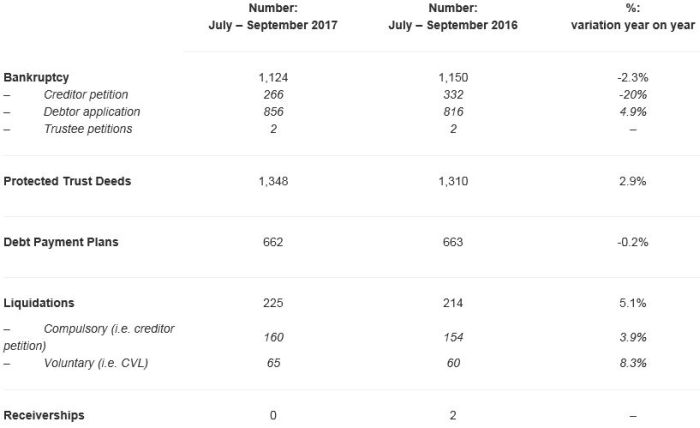Covering formal insolvency processes entered into by individuals and other non-corporate bodies – i.e. Sequestrations (Bankruptcy), Protected Trust Deeds and Debt Payment Plans commenced under the statutory Debt Arrangement Scheme – and certain, devolved corporate processes – i.e. Liquidations and Receiverships – the broad theme was one of consistency, with (low) single-digit percentage variations in the number of each process entered into in this quarter as compared to the same quarter of the preceding year.
Summary of quarterly figures

While steady on an equivalent calendar quarter basis then, the cumulative position across H1 2017-12018 as compared to H1 2016-2017, based on higher volumes of personal insolvencies in Q1, is an increase of 8.5% in non-corporate but a decrease of 12% in corporate processes year on year.
It is worth noting that the AIB, with responsibility for devolved processes only, is not responsible for record keeping or reporting on Administrations or Company Voluntary Arrangements (CVA). Figures for these processes are maintained by The (UK) Insolvency Service (IS) and were published separately, on 27 October 2017. The IS statistics confirm that there were 19 Administration appointments (down 64% against the same quarter in 2016-17) and no CVAs (from 1 in the same quarter last year) in Scotland in the period July – September 2017.
The AIB's full publication on quarterly statistics can be found here
The IS's full publication on UK quarterly statistics can be found here
Lurking beneath the waves?
Meanwhile, warnings of an imminent consumer debt crisis abound, with Standard & Poor last week echoing concern voiced by the Bank of England in September regarding the "rapid growth of consumer credit".
While the Bank of England's financial policy committee pointed to the risks to the financial system as a whole – insisting that capital reserves be increased by £10bn following stress tests which suggested that UK banks would incur losses of an amount broadly equivalent to 20% of their total consumer lending if rates of unemployment and interest increased – S&P focussed on the unsustainability of the sector's growth, warning banks of the risk of overexposure, and that credit ratings could be downgraded if banks appeared to have taken on too much risk in the sector.
All of which suggests that the FCA's launch of its review of the debt management sector, both fee-charging and free-to-consumer, could not have been better timed. With an emphasis on standards and quality of advice offered by firms, on identifying good practice as well as areas of improvement, this thematic review will, it is hoped, encourage best practice in a sector which may soon be called on by banks, as well as by consumers themselves, for expert assistance.
Brodies' expert, top tier Corporate Restructuring and Insolvency team is perfectly placed to assist with concerns regarding solvency risk, offering clear, pragmatic and practical solutions and advice.
The content of this article is intended to provide a general guide to the subject matter. Specialist advice should be sought about your specific circumstances.

